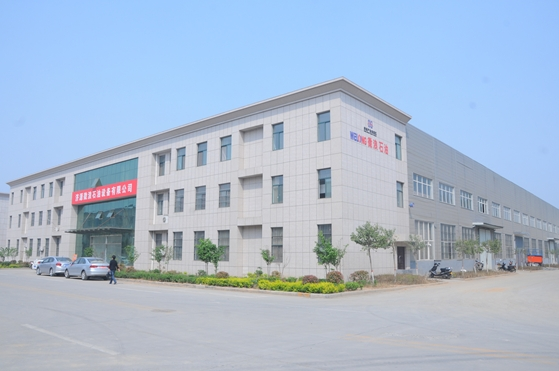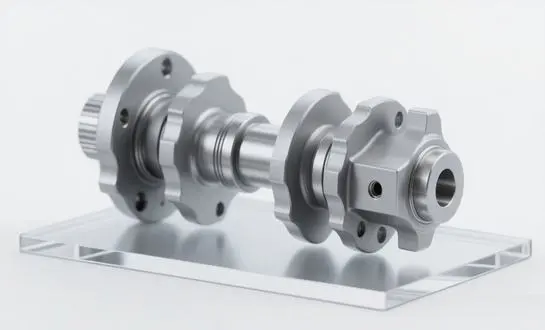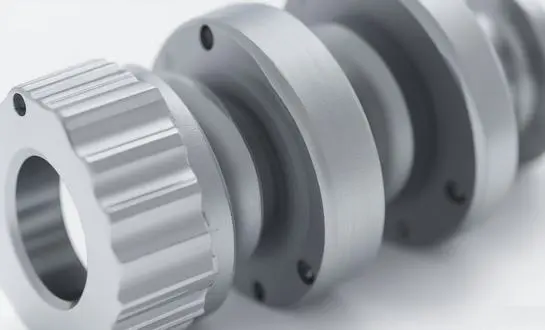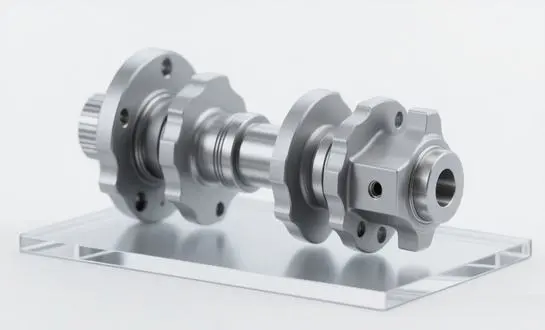As the railway industry continues to advance, the demand for high-quality forged parts grows. These components not only contribute to the overall performance and safety of trains but also play a significant role in reducing maintenance costs and extending the lifespan of railway equipment. Let's delve deeper into the world of forged parts for the rail and locomotive industry, exploring their benefits, applications, and the latest innovations in this critical sector.
How do forged axle shafts improve train safety and performance?
Enhanced structural integrity
Forged axle shafts are renowned for their exceptional structural integrity, which is a direct result of the forging process. During forging, the metal's grain structure is aligned and refined, eliminating potential weak points and inconsistencies that can occur in cast or machined parts. This enhanced grain structure translates to superior strength and durability, allowing forged axle shafts to withstand the immense stresses and loads experienced during train operation.
The improved structural integrity of forged axle shafts significantly contributes to the overall safety of trains. These components are less likely to fail under extreme conditions, reducing the risk of derailments or other catastrophic events. Moreover, the consistent internal structure of forged shafts ensures more predictable performance, allowing for more accurate maintenance schedules and reducing the likelihood of unexpected failures.
Improved fatigue resistance
One of the key advantages of forged axle shafts is their exceptional fatigue resistance. The railway environment subjects components to constant cyclic loading, vibrations, and stress fluctuations. Forged shafts, thanks to their refined grain structure and improved mechanical properties, exhibit superior resistance to fatigue-related failures.
This enhanced fatigue resistance translates to several benefits for train safety and performance. Firstly, it reduces the likelihood of sudden component failure due to accumulated stress over time. Secondly, it allows for longer intervals between maintenance and replacement cycles, improving the overall efficiency and cost-effectiveness of railway operations. Lastly, the improved fatigue resistance contributes to smoother train operation, reducing wear on other components and enhancing passenger comfort.
Optimal weight-to-strength ratio
Forged axle shafts offer an optimal balance between weight and strength, a crucial factor in railway engineering. The forging process allows for the creation of components with complex geometries and varying cross-sections, optimizing material distribution to achieve maximum strength with minimal weight. This weight optimization is particularly important in the rail industry, where every kilogram matters in terms of energy efficiency and overall train performance.
The optimized weight-to-strength ratio of forged axle shafts contributes to improved train performance in several ways. It allows for higher speeds and better acceleration while maintaining safety standards. Additionally, lighter components reduce the overall weight of the train, leading to decreased fuel consumption and lower operational costs. The reduced weight also minimizes wear on tracks and other infrastructure, contributing to the longevity of the entire railway system.
Key standards for railway forged components (e.g., AAR, EN)
Association of American Railroads (AAR) standards
The Association of American Railroads (AAR) sets forth comprehensive standards for railway components, including forged parts, in North America. These standards are crucial for ensuring the safety, interoperability, and performance of rail systems across the continent. For forged components, the AAR standards cover various aspects, including material specifications, manufacturing processes, testing requirements, and quality control measures.
One of the key AAR standards relevant to forged parts is the M-101 specification, which outlines requirements for axles used in freight car applications. This standard details the chemical composition, heat treatment procedures, and mechanical properties that forged axles must meet. Additionally, the AAR M-107/M-208 standard governs the production and testing of wheels, many of which incorporate forged components.
Compliance with AAR standards is mandatory for components used in North American railway systems. These standards ensure that forged parts, including those produced through shaft forging, meet the rigorous demands of the rail industry while maintaining compatibility across different manufacturers and operators.
European Norms (EN) for railway components
In Europe, the European Committee for Standardization (CEN) develops and maintains the European Norms (EN) for railway components. These standards are crucial for ensuring the safety, reliability, and interoperability of rail systems across the European Union and beyond. For forged parts used in the rail and locomotive industry, several EN standards are particularly relevant.
EN 13261 is a key standard that specifies requirements for railway axles. This norm covers various aspects of axle production, including material selection, manufacturing processes (such as shaft forging), heat treatment, and testing procedures. Similarly, EN 13262 outlines specifications for railway wheels, many of which incorporate forged components.
The EN standards also address specific requirements for high-speed rail applications. For instance, EN 13104 and EN 13103 provide guidelines for the design and calculation of axles for high-speed trains, taking into account the unique stresses and loads experienced in these demanding applications.
International Standards Organization (ISO) requirements
While the AAR and EN standards are specific to North America and Europe respectively, the International Standards Organization (ISO) provides globally recognized standards that are often applied to railway components, including forged parts. These ISO standards complement regional norms and are frequently used in international trade and collaboration within the rail industry.
ISO 1005 is a series of standards that specifically addresses railway rolling stock materials and components. Within this series, ISO 1005-3 focuses on axles for tractive and trailing stock, providing guidelines for dimensions, tolerances, and surface finish. These standards are particularly relevant for forged axles and other components produced through shaft forging.
Additionally, ISO 9001, the international standard for quality management systems, is widely adopted in the railway industry. While not specific to forged components, adherence to ISO 9001 ensures that manufacturers of railway parts, including those specializing in forging, maintain consistent quality control processes throughout their operations.
Reducing rail maintenance costs with high-strength forged parts
Extended component lifespan
One of the primary advantages of using high-strength forged parts in rail and locomotive applications is their significantly extended lifespan compared to components manufactured through other methods. The forging process, particularly shaft forging, produces parts with superior mechanical properties and enhanced resistance to wear and fatigue. This inherent durability translates directly into reduced maintenance frequency and lower overall lifecycle costs for railway operators.
Forged components, such as axles, wheels, and connecting rods, can withstand the harsh conditions of railway operations for longer periods without requiring replacement. This extended service life not only reduces the direct costs associated with part replacement but also minimizes the downtime required for maintenance activities. As a result, trains can spend more time in service, improving operational efficiency and revenue generation for railway companies.
Moreover, the predictable performance characteristics of high-strength forged parts allow for more accurate maintenance planning. This predictability enables railway operators to implement proactive maintenance strategies, further reducing the risk of unexpected failures and associated costs.
Improved system reliability
The use of high-strength forged parts significantly enhances the overall reliability of rail systems. The superior mechanical properties of forged components, including their resistance to fatigue, impact, and wear, result in fewer unexpected failures and breakdowns. This improved reliability has a cascading effect on maintenance costs across the entire railway operation.
With more reliable components, railway operators can reduce the frequency of unscheduled maintenance activities, which are often more costly and disruptive than planned maintenance. The reduction in unexpected failures also minimizes the need for emergency repairs, which typically incur premium costs for labor and expedited parts delivery.
Furthermore, the enhanced reliability of forged parts contributes to improved safety in railway operations. By reducing the likelihood of component failures, the risk of accidents or incidents that could result in costly damages, repairs, and potential legal liabilities is significantly diminished.
Optimized maintenance schedules
The use of high-strength forged parts allows for the optimization of maintenance schedules in railway operations. The consistent performance and predictable wear characteristics of forged components enable maintenance planners to develop more efficient and cost-effective maintenance strategies.
With forged parts, maintenance intervals can often be extended without compromising safety or performance. This extension results in fewer maintenance cycles over the lifecycle of the railway equipment, directly reducing labor costs, material expenses, and downtime. Additionally, the ability to predict component life more accurately allows for better planning of major overhauls and refurbishments, enabling railway operators to maximize the utilization of their assets.
The optimization of maintenance schedules also contributes to improved inventory management. With more predictable wear rates and longer component lifespans, railway operators can maintain lower stock levels of spare parts, reducing inventory holding costs and freeing up capital for other investments.
In conclusion, the use of high-strength forged parts, particularly those produced through advanced processes like shaft forging, plays a crucial role in enhancing the safety, performance, and cost-effectiveness of rail and locomotive systems. From improving train safety and adhering to stringent industry standards to significantly reducing maintenance costs, forged components are indispensable in modern railway engineering. As the industry continues to evolve, the demand for high-quality, durable forged parts is likely to grow, driving further innovations in manufacturing processes and materials science.
For more information about high-quality forged parts for the rail and locomotive industry, including specialized shaft forging solutions, please contact us at oiltools15@welongpost.com. Welong is committed to providing cutting-edge forging solutions that meet the exacting standards of the railway industry, ensuring safety, reliability, and efficiency in rail operations worldwide.





